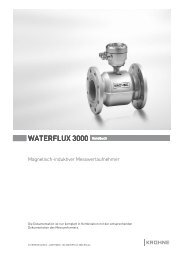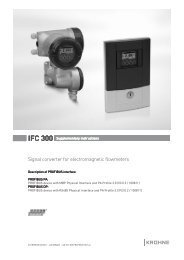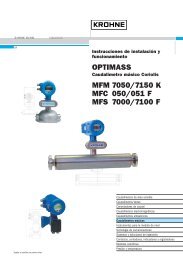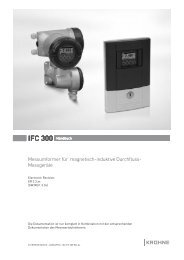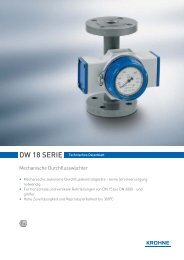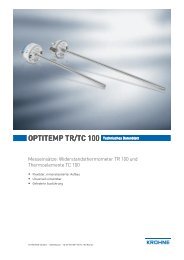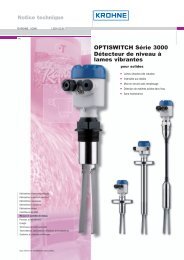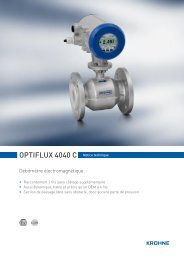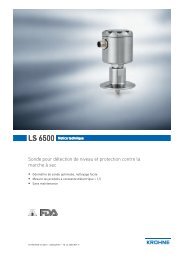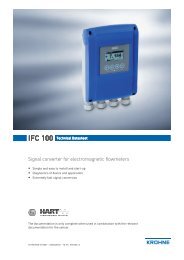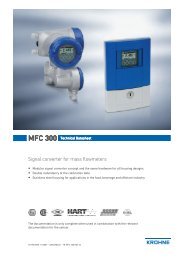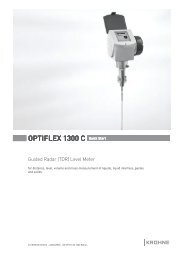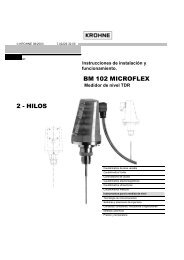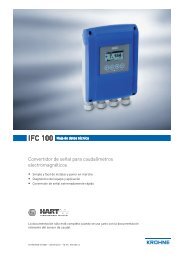ALTOSONIC V12
ALTOSONIC V12
ALTOSONIC V12
You also want an ePaper? Increase the reach of your titles
YUMPU automatically turns print PDFs into web optimized ePapers that Google loves.
<strong>ALTOSONIC</strong> <strong>V12</strong><br />
12-Chord ultrasonic gas flowmeters for custody transfer<br />
Setting a new standard with its OIML R137 Accuracy Class 0.5 approval<br />
Dedicated diagnostic cords for bottom fouling detection<br />
Minimal straight inlet requirement due to excellent swirl immunity<br />
Built-in redundancy through dynamic chord substitution
More than just a meter –<br />
Measurement systems and solutions<br />
For many years KROHNE Oil & Gas has been supplying<br />
complete measurement systems for gas and liquids,<br />
varying from a simple meter run to complete turn-key<br />
measurement skids.<br />
KROHNE Oil & Gas is fully dedicated to custodytransfer<br />
measurement systems and has their own<br />
portfolio of critical products that include flowmeters,<br />
flow computers and supervisory software.<br />
Being part of the global KROHNE Group a local<br />
sales or service contact is never far away, in fact in<br />
most cases the first contact would already be local<br />
and in the local language. By using our own<br />
KROHNE portfolio of instrumentation there is<br />
never a discussion about responsibilities.<br />
2
superior Performance<br />
Certainly the lowest uncertainty<br />
While all flowmeters may show excellent accuracy in<br />
a calibration facility, this is only the tip of the iceberg.<br />
After the meter has been installed in the field,<br />
installation effects and contamination can have a<br />
significant impact on the meter’s overall uncertainty.<br />
Yet, just like the underwater part of an iceberg,<br />
these effects cannot be seen during a calibration.<br />
Looking at the overall uncertainty instead of only<br />
the calibration result, there is a significant difference<br />
between flowmeters approved to OIML R137 class 1<br />
and flowmeters approved to the more stringent<br />
class 0.5. Besides the OIML accuracy, it is also the<br />
ability to detect contamination inside the meter that<br />
will make a significant difference to the overall<br />
uncertainty of your metering installation.<br />
Uncertainty<br />
from calibration<br />
Uncertainty due to<br />
installation effects<br />
Uncertainty due<br />
to contamination<br />
Total uncertainty<br />
after installation<br />
3
Setting a new standard with its<br />
OIML R137 Accuracy Class 0.5 Approval<br />
Where more traditional flowmeters are typically<br />
approved to OIML* R137 class 1, <strong>ALTOSONIC</strong> <strong>V12</strong><br />
is the first flowmeter that has been approved to<br />
class 0.5. The main difference between class 1 and<br />
class 0.5 meters is their immunity to installation<br />
effects such as swirls and distorted flow profiles.<br />
With OIML approvals being issued by independent<br />
third parties such as NMi, the OIML class is a truly<br />
independent approval to prove immunity to<br />
installation effects.<br />
As part of the OIML type testing also non-ideal,<br />
more real life conditions such as upstream bends are<br />
tested. During these tests, class 1 meters are allowed<br />
an additional deviation of 0.33 %, class 0.5 meters are<br />
allowed a deviation of 0.17 %.<br />
The difference in overall accuracy between class 0.5<br />
and class 1 meters is only 0.17 %, however, on a<br />
12” flowmeter, running at 50 bar and at 15 m/s,<br />
this represents a potential loss of € 275,000 per year.<br />
Typically ultrasonic flowmeters will meet a ± 0.2 %<br />
accuracy (or ± 0.1 % after multi-point linearization) in<br />
a calibration facility where the installation conditions<br />
are ideal.<br />
* OIML is the Organization Internationale de Métrologie Légale =<br />
international organization for legal metrology.<br />
4
superior Performance<br />
+1.0<br />
MEASUREMENT ACCURACY<br />
+0.5<br />
0<br />
-0.5<br />
CLASS<br />
1.0<br />
Other<br />
Meters<br />
Installation Uncertainty<br />
Installation Uncertainty<br />
CLASS<br />
0.5<br />
<strong>V12</strong><br />
ACCURACY ACHIEVED DURING CALIBRATION<br />
-1.0<br />
The difference in measurement uncertainty between class 1 and class 0.5 meters is 0.17 %.<br />
The example below shows what this means in terms of financial risks:<br />
12”, 600#, flowmeter (ID 0.295 m)<br />
P = 50 bar<br />
V = 15 m/s<br />
Z (compressibility) = 0.89<br />
Costs = € 0.1/Nm 3<br />
Measurement area:<br />
0.25 x Pi x 0.2952 = 0.068345 m 2<br />
Flow per second:<br />
Measurement area x 50 x 0.89 x 15 = 45.6 Nm 3 /s ≈ € 4.50/s<br />
Per year this is<br />
Flow per second x 60 x 60 x 24 x 365 ≈ € 145 million/year<br />
0.017 % uncertainty results in<br />
0.0017 % x Flow per year ≈ 275,000/year<br />
5
superior Performance<br />
Dedicated diagnostics cords<br />
for bottom fouling detection<br />
Contamination inside a flowmeter will influence its<br />
accuracy. Where mechanical meters have no means<br />
to detect contamination, ultrasonic flowmeters have<br />
diagnostics to monitor what is happening inside the<br />
meter. More standard ultrasonic flowmeters have<br />
basic diagnostics that allow detection of major<br />
contaminations such as a blocked hole in a flow<br />
conditioner. <strong>ALTOSONIC</strong> <strong>V12</strong> uses a single bounce in<br />
each chord to detect even the smallest amount of<br />
contamination. In addition, it is the first flowmeter<br />
that has a vertical acoustic chord to detect<br />
contamination on the bottom of the meter. A thin<br />
layer of contamination will have a big impact on the<br />
financial risks; even a layer of contamination as thin<br />
as 0.5 mm in a 12 ” flowmeter can result in a financial<br />
loss of € 485,000 per year.<br />
<strong>ALTOSONIC</strong> <strong>V12</strong> reliably sees local fouling. Due to a single bounce in plane,<br />
contamination will be detected long before the measurement is impaired.<br />
6
long-term Reliability<br />
Built-in redundancy through<br />
dynamic chord substitution<br />
In the rare case of a transducer failure,<br />
<strong>ALTOSONIC</strong> <strong>V12</strong> uses dynamic chord substitution.<br />
If a chord did fail, the previously stored velocity ratios<br />
between the different chords are used to calculate<br />
the exact velocity at the position of the failed chord.<br />
This method allows <strong>ALTOSONIC</strong> <strong>V12</strong> to remain within<br />
custody transfer accuracy even if two paths were<br />
to fail.<br />
<strong>ALTOSONIC</strong> <strong>V12</strong><br />
measures the flow in<br />
five horizontal planes.<br />
Compared to a more<br />
traditional four-path<br />
configuration, a fifth<br />
measurement plane<br />
was added to improve<br />
the sensitivity to<br />
distorted flow profiles.<br />
While some meters offer<br />
a fifth path through the<br />
centre as an option,<br />
<strong>ALTOSONIC</strong> <strong>V12</strong> offer this<br />
as a standard. The single<br />
bounce in each plane<br />
makes <strong>ALTOSONIC</strong> <strong>V12</strong><br />
virtually immune to swirl<br />
and cross-flows, thus<br />
permitting the shortest<br />
upstream requirements.<br />
<strong>ALTOSONIC</strong> <strong>V12</strong> is the<br />
first meter to offer an<br />
ultrasonic chord that<br />
is fully dedicated to<br />
detection of bottom<br />
fouling.<br />
While more traditional<br />
meters can find major<br />
blockages, such as a<br />
blocked hole in the flow<br />
conditioner, the vertical<br />
diagnostics chord allows<br />
<strong>ALTOSONIC</strong> <strong>V12</strong> to detect<br />
very thin layers of<br />
contamination at the<br />
bottom of the meter.<br />
7
innovative Construction<br />
<strong>ALTOSONIC</strong> <strong>V12</strong> –<br />
12 chords using a single V-bounce<br />
<strong>ALTOSONIC</strong> <strong>V12</strong> uses 10 horizontal measurement<br />
chords to measure the flow inside the meter.<br />
Two additional vertical chords are used to detect<br />
bottom-fouling, making a total of 12 acoustic chords<br />
using a single V bounce configuration.<br />
The single V-bounce gives <strong>ALTOSONIC</strong> <strong>V12</strong> its<br />
extremely high immunity to swirl. In addition, it gives<br />
<strong>ALTOSONIC</strong> <strong>V12</strong> the ability to detect contamination on<br />
the pipe wall. As explained on the previous page,<br />
a 0.5 mm layer of contamination in a 12” meter could<br />
have a massive financial impact; this contamination<br />
should not remain undetected! The single bounce<br />
permits detection of small layers of contamination<br />
while AGC (Automatic Gain Control) guarantees the<br />
integrity of the ultrasonic signal.<br />
The positioning of the measurement paths close to the<br />
top and bottom of the meter as well as in the centre<br />
makes the meter virtually immune to flow profile<br />
changes and distorted flow profiles. Especially the<br />
path in the centre of the meter is important; at this<br />
position, the flow is most sensitive to flow profile<br />
changes and, for a meter to be fully immune to flow<br />
profile changes, it is important to understand how the<br />
profile has changed.<br />
The result is a flowmeter that is more resilient to<br />
distorted flow profiles and swirl, therefore being<br />
awarded OIML R137 class 0.5 approval versus class 1<br />
approval for more traditional meters. Moreover,<br />
it only requires only half the upstream inlet piping,<br />
5D with flow conditioner compared to 10D with<br />
flow conditioner for more traditional meters.<br />
9
What the standards say<br />
AGA 9 Upstream piping requirements<br />
An often heard<br />
misunderstanding<br />
is that AGA 9<br />
prescribes meters<br />
have to be installed with 20D upstream<br />
piping with a flow conditioner. This is<br />
not the case; AGA 9 (paragraph 7.2.2)<br />
states ‘The manufacturer shall<br />
recommend installation criteria that<br />
will not create an additional flow rate<br />
measurement error of more than<br />
± 0.3 %. If this option is not available,<br />
one conservative design is to use 20D<br />
upstream piping with a flow conditioner.<br />
Where more traditional flow meters<br />
might need 20D straight upstream piping<br />
with a flow conditioner to remain within<br />
the 0.3 %, <strong>ALTOSONIC</strong> <strong>V12</strong> only requires<br />
5D and flow conditioner or 10D without<br />
flow conditioner to guarantee a deviation<br />
of less than 0.17 % about responsibilities.<br />
Easy to engineer:<br />
Minimal straight<br />
inlet requirements<br />
Due to its integrated swirl compensation,<br />
<strong>ALTOSONIC</strong> <strong>V12</strong> only requires 5D with<br />
flow conditioner or 10D without flow<br />
conditioner. This not only minimizes the<br />
weight and footprint of your installation,<br />
but also saves on installation- and<br />
shipping costs, both during new<br />
installation as well as during re-calibration.<br />
This much shorter installation<br />
length permits planning more compact<br />
new metering runs and slot-in<br />
replacement of conventional meters<br />
such as turbines during revamps.<br />
OIML R137<br />
Upstream piping requirements<br />
OIML R137<br />
(paragraph 7.4.8)<br />
prescribes that a meter<br />
shall be type-tested with<br />
vendor recommended upstream piping<br />
against the upstream disturbances as<br />
per annex B. During these tests the<br />
shift of the error curve shall not exceed<br />
1/3rd of the accuracy class. This means<br />
that meters that have an OIML R137<br />
class 1 approval are allowed to deviate<br />
up to 0.33 % during type-testing. With<br />
its class 0.5 approval <strong>ALTOSONIC</strong> <strong>V12</strong><br />
is only allowed to deviate 0.17 %.<br />
10
innovative Construction<br />
Without Flow Conditioner<br />
min. 2D<br />
max 5D<br />
min. 10D<br />
min. 3D<br />
With Flow Conditioner<br />
KROHNE<br />
Flow Conditioner<br />
min. 2D<br />
max 5D<br />
min. 2D straight inlet<br />
length required before<br />
flow conditioner<br />
min. 3D<br />
min. 3D<br />
Under specific conditions, <strong>ALTOSONIC</strong> <strong>V12</strong> can<br />
be installed with just 5D and no flow conditioner,<br />
please consult KROHNE if this option is required.<br />
11
long-term Reliability<br />
Can bouncing chords fail due to contamination?<br />
A persistent myth is that bouncing<br />
paths will fail due to contamination.<br />
This is simply not true.<br />
<strong>ALTOSONIC</strong> <strong>V12</strong> uses AGC (Automatic<br />
Gain Control) to compensate for a<br />
possible deterioration of the acoustic<br />
signal due to heavy contamination<br />
inside the flowmeter. Test results show<br />
that even from an extremely rough<br />
surface, simulating a very thick layer<br />
of pollution, the reliability of<br />
<strong>ALTOSONIC</strong> <strong>V12</strong>’s acoustic signals<br />
remains 100 %.<br />
Reflectors used for signal reliability testing:<br />
left clean, centre slightly roughened,<br />
right considerably roughened<br />
Transducer extraction –<br />
Hot swapping with zero downtime<br />
With the optional transducer extraction<br />
tool, transducers can be removed even<br />
when the pipeline is under pressure up<br />
to 150 bar.<br />
Optional transducer retraction tool for replacing<br />
transducers without de-pressurizing the pipeline<br />
This tool is only required when the<br />
pipeline is under pressure, in a<br />
depressurized pipeline the transducers<br />
can be removed with basic tools.<br />
12
long-term Reliability<br />
Web-enabled diagnostics<br />
To guarantee the reliability of the flow measurement,<br />
each <strong>ALTOSONIC</strong> <strong>V12</strong> is equipped with basic diagnostics.<br />
Amongst others the velocity of sound per<br />
paths, the SNR (Signal to Noise Ratio), the AGC<br />
(Automatic Gain Control), and the minimum and<br />
maximum velocities are continuously monitored<br />
in the <strong>ALTOSONIC</strong> <strong>V12</strong> electronics.<br />
With the optionally integrated diagnostics board a very<br />
powerful diagnostics expert system becomes available<br />
that allows the user to quickly analyze the meter’s<br />
performance. The diagnostics package can be used<br />
at multiple levels, from a basic level where a ‘traffic<br />
light’ indicates the overall health of the meter to a<br />
detailed view of long term trending of individual<br />
parameters. The whole package runs on an integrated<br />
web server, meaning no software has to be installed<br />
on a PC – a standard web browser is sufficient.<br />
Once a PC is connected to <strong>ALTOSONIC</strong> <strong>V12</strong> the<br />
diagnostics pops up as a web page. In case<br />
<strong>ALTOSONIC</strong> <strong>V12</strong> is connected to the SUMMIT 8800 flow<br />
computer, the diagnostics can even be reviewed on the<br />
full colour touch screen of the flow computer.<br />
To make sure no events are overlooked, or a problem<br />
is only found after the operator connected a PC to<br />
the flow meter, the diagnostics runs 24/7 on a<br />
dedicated diagnostics board that is mounted inside<br />
the <strong>ALTOSONIC</strong> <strong>V12</strong> electronics housing. This board<br />
has also a limited flow-computer functionality.<br />
When a pressure and temperature measurement,<br />
and possibly a GC input, are connected to the<br />
diagnostics board, the board will calculate a<br />
normalized flow using AGA8 or NX19 equations.<br />
Performance monitoring screen<br />
Alarm caused by bottom fouling<br />
13
The <strong>ALTOSONIC</strong> <strong>V12</strong> range –<br />
The right meter for whatever metering situation<br />
<strong>ALTOSONIC</strong> <strong>V12</strong><br />
While <strong>ALTOSONIC</strong> <strong>V12</strong> offers an excellent solution<br />
for high accuracy measurement of natural gas,<br />
the application might have specific requirements that<br />
could demand a different approach. To meet these<br />
requirements <strong>ALTOSONIC</strong> <strong>V12</strong> is available in the<br />
alternative designs below. Detailed informational<br />
material and complete specifications for the special<br />
purpose <strong>ALTOSONIC</strong> <strong>V12</strong>’s are available upon request.<br />
Please contact KROHNE.<br />
<strong>ALTOSONIC</strong> <strong>V12</strong> Twin<br />
The <strong>ALTOSONIC</strong> <strong>V12</strong> Twin combines two independent<br />
flowmeters in a single body. The design permits two<br />
completely independent measurements with the<br />
installation of just a single flowmeter.<br />
<strong>ALTOSONIC</strong> <strong>V12</strong><br />
With reflective chords<br />
<strong>ALTOSONIC</strong> <strong>V12</strong> Twin<br />
Two meters in a single body with<br />
essentially identical upstream conditions<br />
14
<strong>ALTOSONIC</strong> <strong>V12</strong> Direct<br />
To measure natural gas with extremely high<br />
concentrations of CO 2<br />
the <strong>ALTOSONIC</strong> <strong>V12</strong> Direct is the<br />
answer. This meter uses direct paths instead of single<br />
bounces. The main advantage is a shorter path length,<br />
meaning the ultrasonic sound signal travels a shorter<br />
distance through the highly attenuating CO 2<br />
gas.<br />
The trade-off is that a direct path design has<br />
limitations in detecting small amounts of<br />
contamination inside the meter and is more sensitive<br />
to upstream disturbances than a design that<br />
compensates for swirl by a single bounce.<br />
As a result, <strong>ALTOSONIC</strong> <strong>V12</strong> Direct requires<br />
a 10D straight inlet with flow conditioner.<br />
<strong>ALTOSONIC</strong> <strong>V12</strong> Reference<br />
<strong>ALTOSONIC</strong> <strong>V12</strong> Reference is designed to guarantee<br />
the absolutely highest level of immunity against<br />
upstream disturbances and contamination.<br />
The instrument has an integrated flow conditioner<br />
and is standard produced in Stainless Steel 316.<br />
The standard calibration of <strong>ALTOSONIC</strong> <strong>V12</strong> Reference<br />
is done at 10 different flow rates.<br />
<strong>ALTOSONIC</strong> <strong>V12</strong> Reference is specifically designed for<br />
use in calibration facilities and very high-end<br />
custody-transfer applications.<br />
<strong>ALTOSONIC</strong> <strong>V12</strong> Direct<br />
Transducer arrangement for high CO 2<br />
<strong>ALTOSONIC</strong> <strong>V12</strong> Reference<br />
For use in calibration facilities<br />
15
Technical Data<br />
Functions<br />
Device<br />
Description<br />
Measurement functionality<br />
Applications<br />
Nominal diameter<br />
[mm]<br />
[inches]<br />
Measurement accuracy<br />
Accuracy<br />
(relative to calibration facility)<br />
Repeatability ≤ ± 0.1 %<br />
Ultrasonic gas flowmeter<br />
<strong>ALTOSONIC</strong> <strong>V12</strong> consists of a meter body with ultrasonic transducers and a converter box for signal<br />
processing and counter display mounted on top of the meter body<br />
Actual volume flow rate and totalized volume; bi-directional<br />
Natural gas with a minimum of 75 % methane, other applications on request<br />
100, 150, 200, 250, 300, 350, 400, 450, 500, 600, 750, 900, 1000, 1200, 1400, 1600, others on request<br />
4 ”, 6 ”, 8 ”, 10 ”, 12 ”, 14 ”, 16 ”, 18 ”, 20 ”, 24 ”, 30 ”, 36 ”, 40 ”,42 ”, 48 ”, 56 ”, 64 ”, others on request<br />
Other diameters on request<br />
≤ ± 0.5 % of measured value, uncalibrated<br />
≤ ± 0.2 % of measured value, high-pressure flow calibrated<br />
≤ ± 0.1 % of measured value, high-pressure flow calibrated and linearized<br />
Operating conditions<br />
Flow range<br />
See flow table (last page)<br />
Pressure<br />
4...450 bar; 0.4...45 Mpa; 60...6,525 psi<br />
Ambient temperature -40...+60 °C / -40…+140 °F<br />
Process temperature<br />
Wet gas content<br />
CO2 content<br />
Materials<br />
Flanges<br />
Measuring tube<br />
Electronics housing<br />
Finish<br />
-20...+100 °C; -4…+212 °F (-40…+100 °C; -40…+212 °F optional)<br />
Contact KROHNE<br />
Contact KROHNE<br />
Low temperature carbon steel A350 LF2, stainless steel, duplex<br />
Low temperature carbon steel A350 LF2 (≤ 12 ”) or A333 GR6 (≥ 14 ”), stainless steel, duplex<br />
Stainless steel A316<br />
Outside: 3-layer epoxy coating RAL 9006 (silver)<br />
Inside: corrosion preservative oil film<br />
other finishes on request<br />
16
Electrical connection<br />
Power supply 24 VDC / ≤ 10 W<br />
Inputs / Outputs without integrated diagnostics board with integrated diagnostics board<br />
Digital output 4x output 5x output<br />
Serial 2x modbus over RS 485 3x modbus over RS 485<br />
Ethernet<br />
2x Ethernet<br />
Analog Output<br />
1x 4-20 mA<br />
Input<br />
1x multidrop (dual) HART<br />
Approvals<br />
Custody transfer OIML R137 class 0.5 by NMi<br />
MID (Measurement Instrument Directive 2004/22/EC) by NMi<br />
Fully complaint to AGA 9 and ISO 17089<br />
Hazardous Area<br />
Protection<br />
Verifications<br />
Standard<br />
ATEX: II 2G Ex de ma IIB T5<br />
IECEx: Ex de ma IIB T5 Gb<br />
CSA: Class I, Div 1 and 2, Groups B, C, D T6 …T4 and Class II, Div 1 and 2, Groups E, F, G<br />
FM: Class I, Div 2, Groups C, D T5 and Class II, Div 1, Groups E, F, G (Type 4X)<br />
FM: Class I, Zone 1, Aex de ma IIB T5, IP66<br />
IP66 and NEMA4X NEMA 4x<br />
Hydrostatic pressure test, leakage test on nitrogen<br />
17
Dimensions and weights<br />
Diameter<br />
inch (nom)<br />
Height<br />
inch<br />
Length<br />
inch<br />
Weight<br />
lbs<br />
Diameter<br />
mm (nom)<br />
Height<br />
mm<br />
Length<br />
mm<br />
Weight<br />
kg<br />
Diameter<br />
inch (nom)<br />
Height<br />
inch<br />
Length<br />
inch<br />
Weight<br />
lbs<br />
Diameter<br />
mm (nom)<br />
Height<br />
mm<br />
Length<br />
mm<br />
Weight<br />
kg<br />
4 20.47 11.81 262 100 520 300 119<br />
4 20.47 11.81 284 100 520 300 129<br />
6 22.44 17.27 436 150 570 450 198<br />
6 22.44 17.72 480 150 570 450 218<br />
8 24.41 23.62 664 200 620 600 301<br />
8 24.41 23.62 730 200 620 600 331<br />
ASME 150<br />
10 25.98 29.53 919 250 660 750 417<br />
12 29.13 35.43 1556 300 740 900 706<br />
14 30.71 41.34 589 350 780 1050 267<br />
16 33.07 47.24 827 400 840 1200 375<br />
ASME 300<br />
10 26.77 29.53 1025 250 680 750 465<br />
12 29.92 35.43 1631 300 760 900 740<br />
14 31.89 41.34 756 350 810 1050 343<br />
16 34.25 47.24 1025 400 870 1200 465<br />
18 35.04 53.15 1091 450 890 1350 495<br />
18 36.22 53.15 1369 450 920 1350 621<br />
20 37.01 59.06 1468 500 940 1500 666<br />
20 38.58 59.06 1795 500 980 1500 814<br />
24 41.34 70.87 2381 600 1050 1800 1080<br />
24 43.31 70.87 2901 600 1100 1800 1316<br />
4 20.47 15.75 309 100 520 400 140<br />
4 20.47 15.75 335 100 520 400 152<br />
6 22.64 17.72 547 150 575 450 248<br />
6 23.23 17.72 602 150 590 450 273<br />
8 24.80 23.62 829 200 630 600 376<br />
8 25.98 23.62 950 200 660 600 431<br />
ASME 600<br />
10 27.95 29.53 1208 250 710 750 548<br />
12 30.71 35.43 843 300 780 900 836<br />
14 32.09 41.34 910 350 815 1050 413<br />
16 34.65 47.24 1301 400 880 1200 590<br />
ASME 900<br />
10 28.74 29.53 1334 250 730 750 605<br />
12 31.89 47.24 2075 300 810 1200 941<br />
14 33.07 41.34 1144 350 840 1050 519<br />
16 35.04 47.24 1479 400 890 1200 671<br />
18 36.61 53.15 1687 450 930 1350 765<br />
18 37.80 53.15 2041 450 960 1350 926<br />
20 39.37 59.06 2211 500 1000 1500 1003<br />
20 40.16 59.06 2623 500 1020 1500 1190<br />
24 43.31 70.87 3435 600 1100 1800 1558<br />
24 45.67 70.87 4691 600 1160 1800 2128<br />
18
Flow table<br />
Diameter<br />
inch (nom)<br />
Height<br />
inch<br />
Length<br />
inch<br />
Weight<br />
lbs<br />
Diameter<br />
mm (nom)<br />
Height<br />
mm<br />
ASME 2500<br />
ASME 1500<br />
Length<br />
mm<br />
Weight<br />
kg<br />
Diameter<br />
Qmin<br />
(m 3 /h)<br />
Qmax<br />
(m 3 /h)<br />
Turn down<br />
4 20.87 15.75 399 100 530 400 181<br />
6 23.62 23.62 717 150 600 600 325<br />
8 25.97 31.50 1069 200 660 800 485<br />
10 29.92 39.37 1753 250 760 1000 795<br />
12 33.86 47.24 2734 300 860 1200 1240<br />
14 37.01 55.12 3495 350 940 1400 1585<br />
16 39.37 62.99 4520 400 1000 1600 2050<br />
18 42.13 70.87 tba 450 1070 1800 tba<br />
20 44.49 8.74 tba 500 1130 2000 tba<br />
24 50.00 94.49 tba 600 1270 2400 tba<br />
4 22.61 19.69 677 100 574 500 307<br />
6 26.80 29.53 1217 150 681 750 552<br />
8 28.68 39.37 1819 200 729 1000 825<br />
10 33.21 49.21 3318 250 844 1250 1505<br />
12 37.27 59.06 4961 300 947 1500 2250<br />
Values for larger diameters upon request.<br />
4 25 800 32<br />
6 45 1800 40<br />
8 75 3000 40<br />
10 110 4800 43<br />
12 140 6600 47<br />
14 170 8000 47<br />
16 210 10100 48<br />
18 240 12500 52<br />
20 260 14800 56<br />
24 285 20600 72<br />
28 400 33200 83<br />
30 430 38300 89<br />
32 450 43800 97<br />
36 500 50100 >100<br />
38 520 54900 >100<br />
40 560 58200 >100<br />
42 620 62100 >100<br />
48 810 81200 >100<br />
56 1110 111400 >100<br />
64 1450 145200 >100<br />
Qt = 0.1xQmax<br />
For piping > Sch 80 values might vary.<br />
Calculations are provided as indication,<br />
please ask KROHNE for detailed sizing.<br />
19
© KROHNE 08/2011 - All rights reserved<br />
Subject to change without notice - Errors and omissions excepted<br />
KROHNE Oil & Gas<br />
Overview<br />
Systems<br />
• Flowmeters for custody transfer<br />
• Liquid flowmetering systems<br />
• Gas flowmetering systems<br />
• Wet gas metering systems<br />
• Provers & master meters<br />
• Flow computing, supervisory software &<br />
analyzer management<br />
• Calibration systems<br />
• Tank inventory & management systems<br />
• Analyzer houses and shelters<br />
• Loading & off-loading systems<br />
• Leak detection and localisation systems<br />
• Revamps & upgrades<br />
• Testing, installation, commissioning,<br />
service training<br />
Products<br />
• Gas ultrasonic flowmeters for custody transfer<br />
• Liquid ultrasonic flowmeters for custody transfer<br />
• Mass flowmeters for custody transfer<br />
• Venturis for wet gas metering<br />
• Prover sphere detectors<br />
• Flow computers<br />
• Supervisory systems<br />
• Meter validation software packages<br />
• Electromagnetic flowmeters<br />
• Level measuring instruments<br />
• Variable area flowmeters<br />
• Temperature measuring instruments<br />
• Pressure measuring instruments<br />
• Analyzers<br />
• Vortex flowmeters<br />
• Flow controllers<br />
Contact<br />
Head office KROHNE Oil & Gas<br />
KROHNE Oil & Gas B.V.<br />
Minervum 7441<br />
4817 ZG LH Breda<br />
The Netherlands<br />
Tel.: +31 76 711 200 0<br />
Fax: +31 76 711 200 1<br />
koginfo@krohne-oilandgas.com<br />
Global companies and representatives<br />
The current list of all<br />
KROHNE contacts and<br />
addresses can be found at:<br />
www.krohne-oilandgas.com



